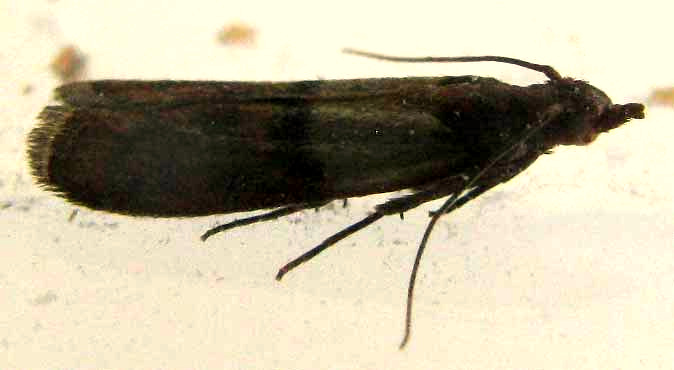Excerpts from Jim Conrad's
Naturalist Newsletter

from the November 3, 2013 Newsletter issued from the Frio Canyon Nature Education Center in the valley of the Dry Frio River in northern Uvalde County, southwestern Texas, on the southern border of the Edwards Plateau; elevation ~1750m (~5750 ft); N29.62°, W99.86°; USA
INDIAN MEAL MOTH
A couple of weeks ago we looked at Rice Weevils in my stored rice. About the same time they were noticed, a jar of rye flour turned up tunneled through and through by some kind of small critter. When the jar was opened, a 3/8th-inch long (9mm), slender moth rested just below the lid, shown above.
The moth is so tiny that it doesn't display a lot of field marks, other than its smallness, narrowness, a pale band across its otherwise dark back, and a fringe of hairs at the wings' back margin. When the jar was emptied of flour, however, another detail helpful for identification emerged, which was that apparently the moth's tunneling larvae produce silk, for, dangling on silk threads from the empty jar's walls were the untidy gobs seen below:

With the picture and these clues Bea in Ontario made quick work of figuring out that we had the Indian Meal Moth, PLODIA INTERPUNCTELLA. The "Indian" part of the common name doesn't refer to Indian folks, except indirectly. Back in the 1850s, New York entomologist Asa Fitch introduced the moth to his readers, and back then cornmeal was referred to as Indian meal. That name cues us to the fact that Indian Meal Moths eat much more than rye flour. Pies, cookies, cakes, breads, cereal, seeds, spices, nuts, pet food, candy bars... just about everything in a kitchen cabinet is food for the Indian Meal Moth.
So, little white caterpillars -- sometimes called waxworms, though other caterpillar types share that name -- hatch from eggs in the flour or whatever, and spin silken galleries from which they sally forth to eat. As they feed and grow, the larvae trail a silken thread which binds food, fecal pellets (poop) and cast-off skins into general messes such as those shown dangling from threads in the last photo.
Indian Meal Moths can pass through their entire life cycle in as few as 30 days, or as many as 300, mostly depending on temperature. Female moths lay between 60 and 400 not-sticky eggs, which hatch in two to fourteen days. The larval stage lasts from two to 41 weeks, depending on temperature. Adults, as moths, are little more than ephemeral sex machines, living only a few days and not even being equipped with mouthparts enabling them to eat.
Indian Meal Moths are native to Asia but now are found in stored food products worldwide.